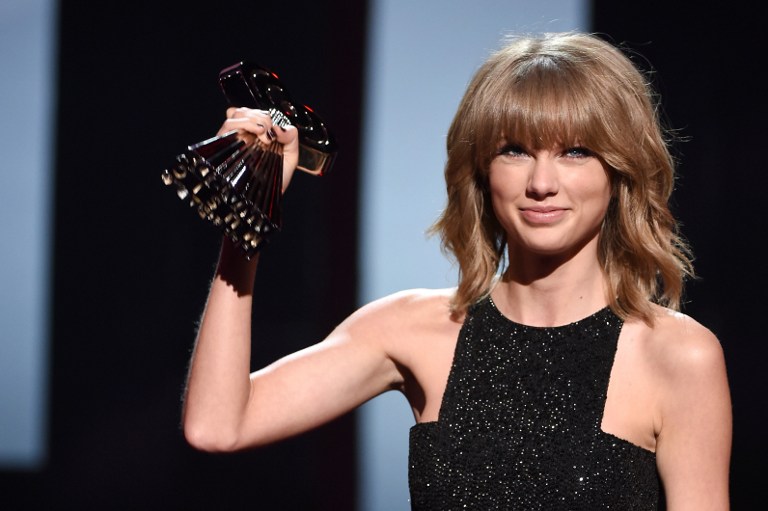Music streaming showdown looms as Spotify competition heats up

Singer-songwriter Taylor Swift accepts the Best Lyrics Award for “Blank Space” during the 2015 iHeartRadio Music Awards at The Shrine Auditorium on March 29 in Los Angeles, California. Swift last year pulled her music from Spotify, urging it to provide more compensation to artists. AFP
STOCKHOLM, Sweden—This week’s all-star launch of US rapper Jay Z’s streaming music service may not have caused Spotify’s management to lose sleep—but analysts predict tough days ahead as tech giant Apple prepares to enter the fray.
The glitzy rebrand of the Tidal service which Jay Z bought from another Swedish firm Aspiro for $56 million was billed as a new departure in streaming: Higher quality audio and owned by artists for artists, not record labels and tech companies.
After a day’s silence the news was welcomed by the world leader Spotify, despite the barely veiled criticism of streaming companies like it from US superstars including Madonna and Alicia Keys at the launch in New York.
Jonathan Forster, Spotify’s vice president for Europe, told AFP in Stockholm that his company welcomed the artists’ initiative.
“I like the rallying cry that artists should get involved … We’re definitely not trying to keep anyone down,” he said.
Spotify has come under fire from artists like British band Radiohead and US pop star Taylor Swift—who has shifted her catalogue to Tidal—protesting that Spotify does not pay artists their fair share.
Its founder Daniel Ek has hit back, saying it had paid out $2 billion (1.85 billion euros) to artists and record labels since it launched in Sweden in 2008.
And music industry watchers have been quick to point out that the artists’ beef is not with Spotify but with their own record labels.
“When it comes down to artists’ payments, all streaming services play by the same rules dictated by the record labels,” said Mark Mulligan at London-based music industry research firm Midia.
According to a study by French music industry trade group SNEP and accounting firm Ernst & Young, recording labels pocket 46 percent of streaming subscription revenues, while artists, publishers and songwriters share 17 percent, with the rest going to streaming providers and taxes.
‘Apple controls the device’
With an estimated 60 million users in 58 countries, including 15 million who pay for ad-free music, Spotify dwarfs Tidal, which had just over half a million users in 31 countries when Jay Z bid for it in January. Spotify also costs half the price at $9.99 compared to $19.99 for Tidal.
Streaming—which allows users to play unlimited on-demand music online—has quickly shaken up the industry, narrowly edging out CD sales in revenues last year in the United States at $1.87 billion.
But the world number one in streaming is a minnow compared to Apple in overall music consumption.
The US giant, which plans to launch its own service in the coming months following its $3.2 billion purchase of Beats Music last year, has about 500 million iTunes users.
“The Apple music service is the one I’d be running scared from if I was Spotify. At the very least 50 percent of Spotify subscribers also happen to be iOS (Apple) device users,” said Mulligan.
“There are endless things Apple can do … because it controls the device and the operating system and everything on it. You could suddenly find this music service on the front screen of your phone.”
In a survey published by Midia this week, 62 percent of music subscribers in the US said they were likely to sign up to the new service.
‘Almost everyone on Earth’
While Apple also has to deal with record labels—reportedly failing recently to secure lower licensing fees—Spotify arguably faces an even bigger challenge from YouTube which offers free music videos available on all devices with an Internet connection.
“As a market leader you’re probably more worried about where people are listening to music on the Internet. More people are listening via YouTube which is owned by Google—the biggest Internet company of all,” said Olle Aronsson, at the Swedish tech news site Breakit, adding that streaming is still in its infancy, representing less than 15 percent of music sales revenue in the US and Britain.
But Spotify, under fire from record label bosses and artists to cut back on its own ad-supported free music—which it uses to attract paying clients—sees free music as the future.
“We’ve always thought that ‘free’ has been a huge part of music wherever you look—historically you had (free music on) the radio and you went out and bought vinyl or cassettes,” said Forster, adding that illegal downloading has made charging for music difficult.
“We also felt that it’s about scale. If you’re talking about a billion or a half a billion users you can start building really interesting free businesses. If you’re an advertising business you can tap into Google or Facebook levels of revenue,” he said.
“The global market of people who like music is almost everyone on Earth.”